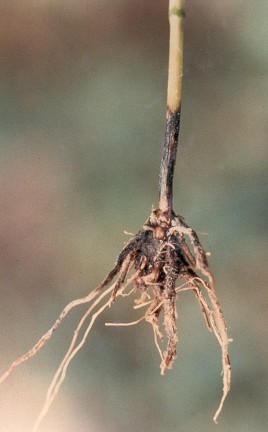Take-all of Wheat
 Causal Agent
Causal Agent
Gaeumannomyces graminis var. tritici (Previously Ophiobolus graminis)
Hosts
Wheat
Symptoms
Take-all damage is most obvious near heading time on plants growing in moist soils. Severely diseased plants pull up rather easily because of the rotted root systems. Infected plants are stunted, chlorotic, have few tillers, and ripen prematurely. Diseased heads have a bleached white appearance and may be sterile or partially filled with shriveled grain. Take-all usually occurs in irregular patches within a field. This disease really does "take-it-all" in these patches, hence the name take-all. The distinct blackening of the root system and crown tissue is the most characteristic symptom of take-all. The take-all fungus survives as a mycelium in infected plant tissue or in sexual fruiting bodies called perithecia. In the fall or early spring, wheat seedlings can become infected when the roots grow into the vicinity of crop residues which the take-all fungus has colonized. Plant-to-plant spread of take-all can occur by hyphae growing through the soil from an infected to a healthy plant or by an infected root coming in contact with a healthy one.
Control
Please contact your local county extension office for current information.

